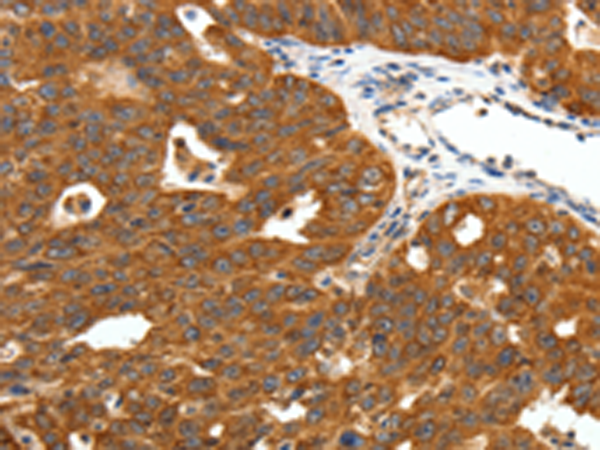

| WB | 咨询技术 | Human,Mouse,Rat |
| IF | 咨询技术 | Human,Mouse,Rat |
| IHC | 1/50-1/200 | Human,Mouse,Rat |
| ICC | 技术咨询 | Human,Mouse,Rat |
| FCM | 咨询技术 | Human,Mouse,Rat |
| Elisa | 1/2000-1/5000 | Human,Mouse,Rat |
| Aliases | NaN; SNS-2; NAV1.9; SCN12A |
| Host/Isotype | Rabbit IgG |
| Antibody Type | Primary antibody |
| Storage | Store at 4°C short term. Aliquot and store at -20°C long term. Avoid freeze/thaw cycles. |
| Species Reactivity | Human, Mouse, Rat |
| Immunogen | Synthetic peptide of human SCN11A |
| Formulation | Purified antibody in PBS with 0.05% sodium azide and 50% glycerol. |
+ +
以下是关于SCN11A抗体的3篇参考文献示例(注:以下内容为示例性概括,具体文献需通过学术数据库核实):
---
1. **标题**: *SCN11A mutations cause familial episodic pain with predominant small fiber neuropathy*
**作者**: Leipold E. et al.
**摘要**: 研究报道SCN11A基因突变导致家族性疼痛综合征,利用SCN11A抗体检测背根神经节中Nav1.9通道蛋白表达异常,揭示其与小纤维神经病理性疼痛的关联。
2. **标题**: *Nav1.9 channel in sensory neurons is critical for inflammatory pain*
**作者**: Priest BT. et al.
**摘要**: 通过SCN11A抗体进行免疫组化分析,证实Nav1.9在炎症性疼痛模型中的上调表达,抗体特异性验证为研究钠通道靶向治疗提供依据。
3. **标题**: *Antibody-based profiling of voltage-gated sodium channels in human dorsal root ganglia*
**作者**: Bennett DL. et al.
**摘要**: 利用SCN11A抗体对人类背根神经节样本进行蛋白定位研究,揭示Nav1.9在慢性疼痛患者中的分布变化及潜在诊断价值。
---
如需具体文献,建议通过PubMed或Google Scholar以关键词“SCN11A antibody”或“Nav1.9 antibody”检索近年研究。
The SCN11A antibody is a crucial tool in neuroscience and pain research, targeting the voltage-gated sodium channel Nav1.9 encoded by the *SCN11A* gene. Nav1.9 is predominantly expressed in peripheral sensory neurons, particularly nociceptors, and plays a key role in modulating neuronal excitability, pain signaling, and inflammatory responses. Unlike other sodium channel isoforms (e.g., Nav1.7 and Nav1.8), Nav1.9 is considered a "threshold channel," influencing subthreshold depolarization and amplifying sustained pain signals.
SCN11A antibodies are widely used to study Nav1.9's expression, localization, and function in both physiological and pathological contexts. Research has linked *SCN11A* mutations to human pain disorders, including inherited small fiber neuropathy and familial episodic pain syndromes, making these antibodies vital for investigating disease mechanisms. They are employed in techniques like Western blotting, immunohistochemistry, and immunofluorescence to assess protein levels in tissues or cultured cells.
Challenges in developing SCN11A antibodies include sequence homology among sodium channel isoforms, requiring rigorous validation to ensure specificity. Commercial antibodies vary in host species, clonality, and epitope targets, necessitating careful selection based on experimental needs. Beyond basic research, SCN11A antibodies hold potential in drug discovery for chronic pain and neuropathies, as Nav1.9 represents a promising therapeutic target. Their utility extends to biomarker studies, aiding in the molecular characterization of pain-related disorders.
×